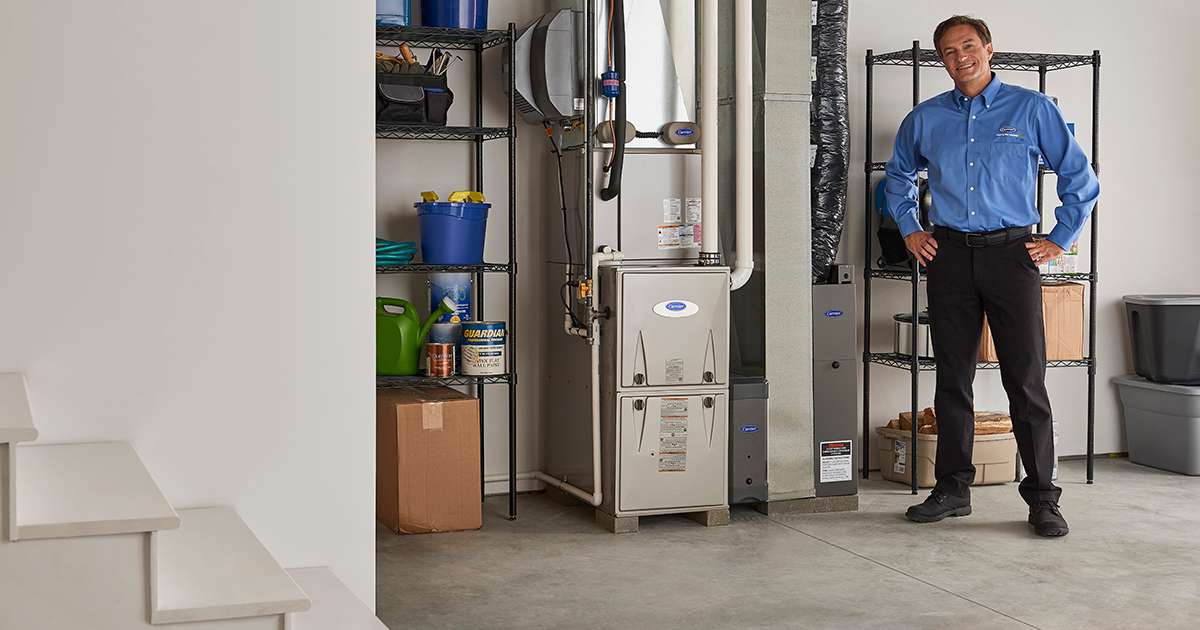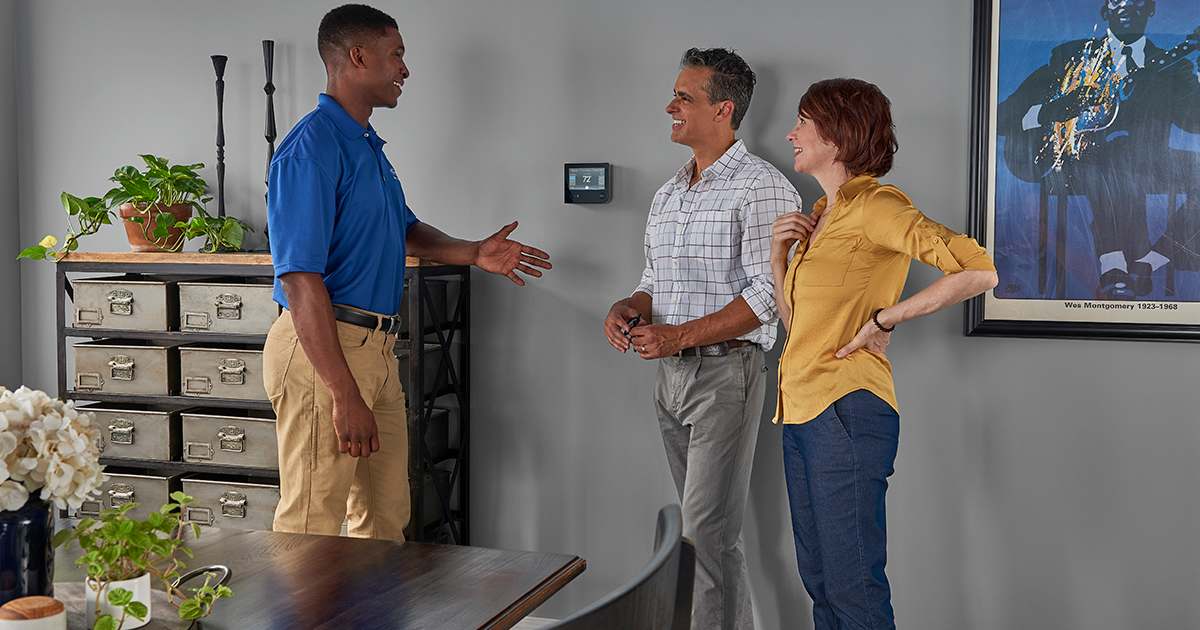How Much Is A New Furnace? A Guide To New Furnace Cost and Furnace Prices
When it comes to heating your home, natural gas furnaces are considered the most popular choice in the United States. So, how much does a gas furnace cost? According to HomeAdvisor, there is a rather wide range – on average, between $3,800-$12,000, including furnace installation costs.1 Such a vast difference in pricing reflects the wide number of variables that go into establishing the final cost. On the low end, the actual cost of the furnace might be less than $3,800 but that doesn’t include any installation labor or other material costs. The high end reflects a deluxe, high-efficiency model but in some cases could cost over $12,000 if new venting is required, plus, other materials and furnace installation labor.

Of course, average costs don’t really tell the whole story. By itself, a new furnace can be an energy-efficient and cost-effective heating system. When installed along with an air conditioner and evaporator coil, it becomes the central part of a complete HVAC system.
For more information on the many types of Carrier furnaces available, check out our furnaces product page. To help you make an informed choice about the right model for your home, this article delves deeper into the details of what factors can affect gas furnace costs.
Cost To Replace Furnace and Furnace Price Variables
The cost of a new gas furnace can vary substantially due to several variables. Starting with the furnace itself, pricing can differ quite a bit based on the efficiency of the unit, its heating capacity (size) and the “bells and whistles” built in. Furnace installation costs will also depend on the complexity of the job. If you are replacing an existing furnace with a similar unit, furnace installation costs will be lower. If your new furnace requires additional labor and materials to run new ductwork or venting, costs will increase. For a deeper dive into replacement costs, check out our article on gas furnace replacement.

Types of Gas Furnaces
Electric furnaces, oil furnaces and natural gas furnaces are the three main types of furnaces sold in the United States. Electric furnaces are found more often in the southern U.S. and oil furnaces are still seen in the northeastern states, but natural gas models are currently the most popular due to the availability and cost-effectiveness of natural gas.
Natural gas models can be further differentiated by their ability to provide different levels, or “stages” of heating output. Here’s a closer look at each type:
A single-stage furnace is the most basic. It operates at 100% of its full heating capacity when turned on, then turns completely off. Single-stage furnaces can be an effective and efficient solution for heating your home. However, indoor temperatures tend to have a wide range of fluctuation, going up and down more frequently than two-stage or modulating stage models. On the positive side, single-stage models are usually among the least expensive.
A two-stage furnace can operate either at reduced heating output (low stage) or at its full capacity (high stage). Two-stage models can cut heating costs and smooth out up-and-down temperature cycles by operating at low stage heating most of the time, then adjusting to high-stage heating as needed. These units are often more expensive than single-stage furnaces but will have a smaller range of temperature fluctuations.
A modulating furnace has multiple heating stages. It can increase or decrease its heating output as needed to most efficiently keep your home at a very consistent temperature. Modulating furnaces are among the most expensive natural gas models due to the technology needed to monitor conditions and adjust furnace capacity. They are also among the most energy efficient models you can buy.
Energy Efficiency
You can check to see how energy efficient a natural gas furnace is by checking its AFUE (Annual Fuel Utilization Efficiency) rating. AFUE is the percentage of the heating fuel used that is converted to heat. Much like miles-per-gallon for your car, a higher AFUE number means a more energy-efficient furnace. Learn more about AFUE.
High efficiency furnaces are typically more expensive than standard or mid-efficiency models. This is due to the additional components and technology needed to make the furnace more energy efficient.

Additional New Furnace Costs
Once you have settled on a furnace, there’s the matter of installation. Furnace installation is not your typical DIY project. There are gas and electrical connections to be made. Venting, ductwork and condensate drains (for condensing furnaces) also need to be connected and setup. In short, your safest and most reliable solution is to pay a licensed professional for the material and labor costs to properly complete the installation.
Here are some sample new furnace cost ranges :
- Labor: Typical labor costs can range from $50 - $100 per hour for a licensed technician. Each additional team member will be an additional charge. Depending upon the complexity of the job, a new furnace installation can take 10-15 hours! 2
- Permits/inspections: Requirements for building permits and inspections will vary based on local regulations. If required, you might expect to pay anywhere from $400 - $1,500. 3
- Furnace removal: Most contractors will remove your old furnace for disposal. The cost for removal and disposal of an old furnace can range from $60 - $500. 3
- Ductwork: If your ductwork requires only simple duct modifications, the costs might be minimal, or up to $1000. For a completely new duct system, the price can add up to as much as $7000. 3
For the best way to get an accurate estimate on new furnace cost for your home, we recommend contacting your local Carrier expert .
How Much Is A New Furnace? Choose the Right Natural Gas Furnace for Your Budget
Choosing the right furnace for your budget is more than just picking an amount you want to spend and sticking to it. Here are some factors to consider:
- Cold Climate - If you live in a cold climate with a longer heating season, a highly efficient, multi-stage and variable-speed furnace can save money on heating costs in the long run, but that can increase the initial cost. Furnace size – or capacity – is affected by climate as well. A furnace in a cold climate home will need to generate more BTUs per square foot to keep up with heating demand.
- Warm\Humid Climate – In warmer climates you might be able to get by with a lower efficiency, single-stage model which tends to be less expensive, but operating costs for the life of the unit are typically higher. If humidity is an issue in your area, a furnace with a variable-speed fan can help reduce indoor humidity when installed as a part of your air conditioning system.
- Energy efficiency – As previously mentioned, high efficiency furnaces are more expensive up-front, but can help save money on your energy bills. Additionally, you may be able to recover some of that initial cost through federal tax credits and utility company rebates for installing a highly efficient gas furnace.
-
Knowing how gas furnaces work may help you understand more about the differences in furnace types and how those differences can affect furnace cost.
![a carrier dealer answers how much does a new furnace cost a carrier dealer answers how much does a new furnace cost]()
How Much Does A New Furnace Cost?
How much does a new furnace cost? New furnace cost can vary significantly. Gas furnaces costs can range from as little as $3,800 for a basic unit with installation to more than $10,000 to $12,000 for a high-efficiency model with professional installation. With such a wide range, it’s important to do your homework – learn about the different types of furnaces available, including technologies that can improve efficiency and comfort. Then contact a local Carrier dealer for recommendations on a new Carrier furnace that best fits your needs.
Yearly Natural Gas Furnace Cost
When you think about natural gas furnace cost, it’s important to remember the ongoing expenses as well. Energy costs, maintenance and repair bills can certainly add up over time. Depending on the efficiency of the model you choose, the size of your home, and the climate you are in, a gas furnace can cost between $400 and $700 annually in fuel usage.4 Annual maintenance can cost $80 - $170, and gas furnace repairs can average between $100 - $600 depending upon the part needed and complexity of the job.5
-
![a man and woman research how much is a new furnace and furnace installation cost a man and woman research how much is a new furnace and furnace installation cost]()
Explore Carrier Furnaces
ENERGY STAR® certified. Up to 97.0% AFUE for premium energy savings with enhanced comfort features.
ENERGY STAR® certified. Up to 97.0% AFUE for premium energy savings with enhanced comfort features.
All sizes ENERGY STAR® certified. Up to 97% AFUE for premium energy savings with standard comfort features.
FAQs About How Much Does A Furnace Cost
Here are some frequently asked questions regarding gas furnace costs:
A well-maintained gas furnace should last 15+ years. Minor repairs before the 15-year time frame are generally a worthwhile investment. If you have an older furnace, it may be time to start comparing prices of a new one.
Look for special off-season furnace pricing from local HVAC contractors, consider a higher efficiency model that qualifies for tax credits or utility company rebates, or include a new furnace when replacing an aging air conditioner.
If your furnace struggles to keep your home warm, runs constantly, turns on and off frequently, or is generating new sounds or smells, contact a reputable local HVAC dealer for a diagnosis.
Carrier has a deep and talented pool of experienced and trusted dealers. Our dealer locator can help you find a qualified professional, including a Carrier Factory Authorized Dealer in your area. Recommendations from friends, relatives or trusted neighbors can be a reliable source as well.
- Read about how a gas furnace works
- Buyers Guide: 10 things to consider when buying a furnace
- Learn about furnace replacement cost vs furnace repair cost
- How long does a furnace last?
- How do gas furnaces work?
- Learn about the benefits of HVAC financing
![a carrier dealer ready to answer questions on gas furnace cost and cost of new furnace a carrier dealer ready to answer questions on gas furnace cost and cost of new furnace]()







